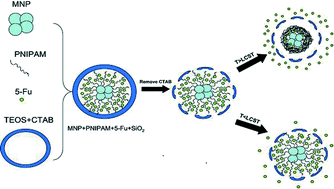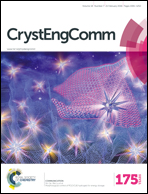Fabrication and potential application of a di-functional magnetic system: magnetic hyperthermia therapy and drug delivery
Abstract
A novel di-functional system was synthesized by encapsulation of superparamagnetic Fe3O4 and a therapeutic agent 5-fluorouracil (5-Fu) with the thermo-responsive poly(N-isopropylacrylamide) (PNIPAM), which was coated with mesoporous SiO2 nanoparticles in a mesoporous core–shell structure. The system featured functionalized magnetic Fe3O4 and a smart thermo-responsive polymer PNIPAM. In an alternating magnetic field (AMF), the magnetic nanoparticles were heated up to 45 °C, which was the cancer treatment temperature. Therefore, it has potential for hyperthermia treatment. The smart polymer PNIPAM has a lower critical solution temperature (LCST), which is representative of a phase transition behavior. Based on it, the thermo-responsive polymer PNIPAM played a role of an on-off trigger switch in the process of drug releasing. The tests of drug releasing were investigated by UV-visible spectrophotometry at 45 °C and 25 °C. The test results showed that there was little drug released at 25 °C (below the LCST) but drug was mainly released at the temperature of 45 °C (above the LCST). In a word, our studies were mainly about the di-function of the composite: magnetic hyperthermia treatment and drug release. It has potential applications for reducing side effects of cancer treatment and achieving controlled drug release in response to variations of temperature.


 Please wait while we load your content...
Please wait while we load your content...